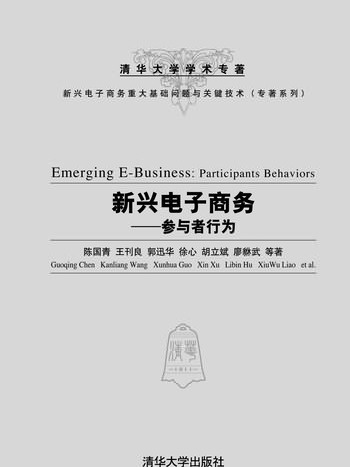內容簡介
新興電子商務與傳統電子商務相比,呈現出移動性(如泛在互聯、移動商務)、虛擬性(如虛擬體驗、賽博空間)、個性化(如精準行銷、推薦服務)、社會性(如社交媒體、社會商務)和極端數據(如富媒體、大數據)等鮮明特徵。本書圍繞新興電子商務若干重要理論與套用課題,從行為視角考察新興電子商務的各類參與者(包括消費者、企業和政府等)在參與電子商務活動時的模式的特徵,展現在新興電子商務環境下的用戶體驗與激勵機制、中國文化背景下的新興信息系統採納、社會化套用與企業及市場的相互影響、面向服務的消費者價值創造、新興商務環境中的外包決策等方面的研究成果。研究內容緊扣現實問題,通過科學凝練和系統性建模,旨在為學界和業界提供對新興環境下電子商務參與者行為規律的深入詮釋,並為相關研究提供理論參考和實證依據。
本書主要面向高校和科研單位的碩士研究生、博士研究生和學者。對企業套用和研發人員也具有參考價值。
圖書目錄
第1章引言
第2章從免費試用到產品採納和購買
2.1信息技術採納、購買與行銷
2.2研究的理論基礎
2.2.1實際使用前後的個人感知
2.2.2產品試用形式的行銷手段
2.2.3信息技術採納研究中的成本因素
2.3研究模型和假設
2.3.1試用體驗評價
2.3.2試用體驗的效果
2.3.3感知產品價格
2.3.4試用後消費者感知
2.4研究方法
2.4.1研究情境
2.4.2問卷設計與數據收集
2.5數據分析
2.5.1測量模型檢驗
2.5.2模型結構檢驗
2.6研究結果
2.7研究價值
2.7.1理論價值
2.7.2實踐價值
2.8本章小結
第3章電子商務推介激勵機制中的社會距離與規範
3.1引言
3.2電子商務推介激勵機制簡介
3.2.1推介激勵機制的來源
3.2.2推介激勵機制在電子商務中的現狀
3.2.3推介激勵機制中邀請雙方的行為特點
3.3推介激勵機制的情境因素
3.3.2社會距離對推介雙方行為規範的影響
3.3.3推介激勵機制中的社會規範
3.3.4推介激勵機制中的市場規範
3.3.5社會規範與市場規範的互動影響
3.3.6社會距離對推介雙方行為規範的影響分析
3.4中國文化背景的影響
3.5推介雙方行為特點對推介激勵機製成功率的影響
3.5.1消費者捲入理論
3.5.2推介雙方捲入程度對其行為規範的影響
3.5.3推介雙方捲入程度與推介激勵機製成功率
之間的關係
3.6實驗研究與實驗結果
3.6.1實驗研究
3.6.2實驗結果
3.7結果的分析與討論
3.7.1社會距離的影響
3.7.2社會距離的影響
3.7.3中國文化的影響
3.8本章小結
第4章中國文化背景下的新興信息系統採納
4.1引言
4.2中國用戶信息技術採納的行為演變
4.2.1信息技術採納綜合模型
4.2.2學術環境下的電子學習系統採納
4.2.3政府環境下的電子服務系統採納
4.3採納案例重點分析
4.3.1案例分析綜合方法
4.3.2結構化角度的政務系統採納分析
4.3.3基於TOE框架的開源軟體採納分析
4.4中國文化特質與信息系統採納行為
4.4.1文化價值理論下的信息系統採納
4.4.2中國文化背景下的採納模型
4.4.3模型的實證結果討論
4.5本章小結
第5章Web 2.0環境下的用戶行為及影響
5.1引言
5.2Web 2.0套用的發展與行為影響
5.2.1雙邊市場視角下的電子商務用戶使用行為
5.2.2社會網路環境中小眾文化的傳播機理
5.3企業內部的Web 2.0使用行為模式
5.3.1企業2.0與企業部落格
5.3.2企業部落格的持續使用行為分析
5.3.3企業部落格的用戶使用行為模式與特點
5.4企業內部Web 2.0使用與社會資本結構
5.4.1企業內部部落格與社會資本關係模型
5.4.2關係模型的實證檢驗
5.4.3管理啟示
5.5本章小結
第6章社會化平台與金融市場信息環境
6.1引言
6.2針對市場信息環境的研究問題
6.3社會化媒體影響市場信息環境的實證研究
6.3.1關於市場信息環境的經濟學理論
6.3.2假設
6.3.3實證研究結果
6.3.4進一步思考:公司治理環境
6.4本章小結
7.1引言
7.2多渠道零售服務提供系統的設計
7.2.1多渠道零售服務提供系統設計的理論基礎
7.2.2多渠道零售服務提供系統設計的維度
7.3多渠道零售服務提供系統的實證檢驗
7.3.1消費者對多渠道零售服務的價值評估
7.3.2多渠道零售服務提供系統的商業價值分析
7.4“網上下訂單,實體店自提”服務
7.4.1“網上下訂單,實體店自提”服務在國內外
的情況
7.4.2消費者使用OOIP服務的意向分析
7.5本章小結
第8章IT服務外包決策分析和契約設計
8.1引言
8.2IT服務外包中的外包決策、時機選擇與契約設計
8.2.1模型假設與變數設計
8.2.2模型設計及分析
8.2.3小結
8.3需求不確定條件下的IT服務外包契約設計與分析
8.3.1模型假設與變數設計
8.3.2模型構建與分析
8.3.3算例分析
8.3.4小結
8.4IT服務外包的質量風險防範契約設計與分析
8.4.1問題描述與模型假設
8.4.2質量可精確測度且質量成本信息對稱的
基準模型
8.4.3質量成本信息對稱但質量測度不確定下的道德
風險模型
8.4.4質量成本信息不對稱且質量測度不確定條件下
8.4.5案例說明
8.4.6小結
8.5不完全測度下多目標IT服務外包契約設計與分析
8.5.1問題描述與模型假設
8.5.2模型設計與分析
8.5.3小結
8.6本章小結
參考文獻
索引
Emerging EBusiness: Participants Behaviors
Table of Contents
Table of Contents
Chapter 1Introduction
Chapter 2From Free Trial to Adoption and Purchase
2.1IT Adoption, Purchase, and Marketing
2.2Theoretical Foundation
2.2.1Individual Perceptions Before and After Use
2.2.2Product Trial as A Marketing Method
2.2.3Cost Factors in IT Adoption Research
2.3Research Model and Hypotheses
2.3.1Trial Experience Evaluation
2.3.2Effectiveness of Trial Experience
2.3.3Perceived Product Price
2.3.4PostTrial Consumer Perceptions
2.4Research Method
2.4.1Research Site
2.4.2Questionnaire Design and Data Collection
2.5Data Analysis
2.5.1Measurement Validation
2.5.2Model Structure Validation
2.6Results
2.7Contributions
2.7.1Theoretical Contributions
2.7.2Practical Contributions
2.8Summary
Chapter 3Social Distance and Norms in the Referral Incentive
Mechanisms for Online Business
3.1Introduction
3.2Referral Incentive Mechanisms for Online Business
3.2.1Emergence of Referral Incentive Mechanisms
3.2.2Current Status of Referral Incentive Mechanisms
in
Ecommerce
3.2.3Behavioral Characteristics of Participants in
Referral
Incentive Mechanisms
3.3Contextual Factors for Referral Incentive Mechanisms
3.3.1ContextFree Referral Incentive Mechanisms:
the
Ultimatum Game
3.3.2Impacts of Social Distance on Participants
Behavioral
Norms
3.3.3Social Norms in Referral Incentive Mechanisms
3.3.4Market Norms in Referral Incentive Mechanisms
3.3.5Interactive Effects of Social Norms and Market
Norms
3.3.6Analysis on the Impacts of Social Distance on
Participants Behavioral Norms
3.4Impacts of the Chinese Cultural Background
3.5Impacts of Participants Behavioral Characteristics on
the Success
Rate of Referral Incentive Mechanisms
3.5.1Consumer Involvement Theory
3.5.2Impacts of Participant Involvement on Behavioral
Norms
3.5.3Relationships between Participant Involvement
and the
Success Rate of Referral Incentive
Mechanisms
3.6Experimental Research and Results
3.6.1Experimental Research
3.6.2Results
3.7Analysis and Discussion
3.7.1Impacts of Social Distance
3.7.2Further Discussion on Social Distance
3.7.3Impacts of the Chinese Culture
3.8Summary
Chapter 4Emerging Information Systems Adoption in Chinese
Cultural
Contexts
4.1Introduction
4.2Evolution of IT Adoption Behavior of Chinese Users
4.2.1An Integrated Model for IT Adoption
4.2.2Empirical Research in an Academic Context
4.2.3Empirical Research in a Governmental Context
4.3Case Analysis
4.3.1Case Research Method
4.3.2EGovernment Systems Adoption from a
Structurational
Perspective
4.3.3Open Source Software Adoption Analysis Based
on the
TOE Framework
4.4Chinese Cultural Dimensions and Information Systems
Adoption
4.4.1Cultural Value Theory and Information Systems
Adoption
4.4.2Adoption Model in the Chinese Cultural Context
4.4.3Empirical Research Results
4.5Summary
Chapter 5User Behaviors and Their Consequences in Web 2.0
5.1Introduction
5.2Web 2.0 Applications and User Behaviors
5.2.1Ecommerce User Behaviors from a TwoSided
Market
Perspective
5.2.2Niche Culture Diffusion in Social Networking
Contexts
5.3IntraOrganizational Web 2.0 User Behaviors
5.3.1Enterprise 2.0 and Enterprise Blogs
5.3.2Continued Use of Enterprise Blogs
5.3.3Usage Patterns in Enterprise Blogs
5.4IntraOrganizational Web 2.0 and the Structure of Social
Capitals
5.4.1Theoretical Model for IntraOrganizational Blogs
and
Social Capitals
5.4.2Empirical Validation
5.4.3Managerial Implications
5.5Summary
Chapter 6Social Media Platforms and the Information Environment
of
Finance Markets
6.1Introduction
6.2Research Questions on Market Information Environment
6.3Empirical Research on the Impact of Social Media on
Market
Information Environment
6.3.1Economics Theories on Market Information
Environment
6.3.2Hypotheses
6.3.3Empirical Research Results
6.3.4Further Analysis: Corporate Governance
Environment
6.4Summary
Chapter 7Consumer Value Creation in MultiChannel Retail
Service
Systems
7.1Introduction
7.2Design of MultiChannel Retail Service
Systems
7.2.1Theoretical Foundation
7.2.2Design Dimensions
7.3Empirical Testing for MultiChannel Retail Service
Systems
7.3.1Consumer Evaluation for MultiChannel Retail
Services
7.3.2Analysis on the Business Value of MultiChannel
Retail
Service Systems
7.4OOIP Services
7.4.1Current Practice of OOIP
7.4.2Analysis on the Intention of Consumers to Use
OOIP
Services
7.5Summary
Chapter 8IT Service Outsourcing Decision Making and Contract
Design
8.1Introduction
8.2Decision Making, Timing, and Contract Design for IT
Service
Outsourcing
8.2.1Model Hypotheses and Variables
8.2.2Model Design and Analysis
8.2.3Section Summary
8.3IT Service Outsourcing Contract Design with Demand
Uncertainty
8.3.1Model Hypotheses and Variables
8.3.2Model Design and Analysis
8.3.3Example Analysis
8.3.4Section Summary
8.4Design and Analysis of Quality Risk Protection Contracts
in IT
Service Outsourcing
8.4.1Question Description and Model Hypotheses
8.4.2Baseline Model
8.4.3Moral Risk Model
8.4.4Reverse Selection Model
8.4.5Case Analysis
8.4.6Section Summary
8.5MultiTarget IT Service Outsourcing Contract Design and
Analysis
8.5.1Model Hypotheses and Variables
8.5.2Model Design and Analysis
8.5.3Section Summary
8.6Summary
References
Index

